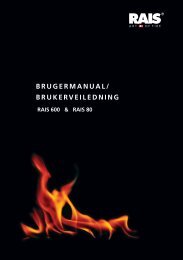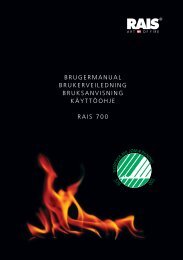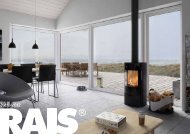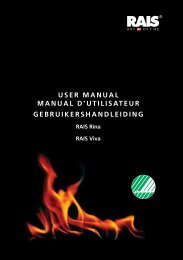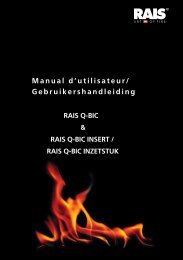pilar - Rais
pilar - Rais
pilar - Rais
Create successful ePaper yourself
Turn your PDF publications into a flip-book with our unique Google optimized e-Paper software.
Français Manuel d’utilisateur pour les modéles PALO, PALO C & PILAR<br />
Flemish Gebruikershandleiding voor PALO, PALO C & PILAR<br />
Dégagements par rapport aux murs combustibles<br />
Afin de déterminer si le mur près duquel votre poêle va être placé est combustible ou non,<br />
veuillez contacter l’architecte qui a conçu le bâtiment ou encore les autorités de la construction<br />
locales.<br />
Dans le cas où le sol est combustible, le poêle doit alors être placé sur quelque chose de<br />
non combustible comme une plaque d’acier, une plaque de verre, du carrelage ou encore<br />
de la pierre.<br />
Vrije ruimte tot brandbare wanden<br />
Contacteer uw architect of de bevoegde overheidsinstanties om te weten of de wand in<br />
de buurt van uw kachel brandbaar is.<br />
Als de vloer brandbaar is, moet de kachel op niet-brandbaar materiaal worden geplaatst,<br />
zoals een stalen plaat, een glazen plaat, tegels of een stenen plaat.<br />
Installation standard / Normale opstelling - PALO & PALO C<br />
(Socle fixe (angle droit) (rechte hoek) vaste sokkel<br />
12<br />
Installation standard / Installation d’angle 45° /<br />
Normale opstelling Hoekmontage 45°<br />
A. Dégagement / Afstand tot meubelen 750 mm 750 mm<br />
Distance de sécurité aux matériaux combustibles / Afstand tot brandbare materialen:<br />
B. devant (sol) vooraan (vloer) 300 mm 300 mm<br />
C. latérale (sol) zijkant (vloer) 150 mm 150 mm<br />
D. arrière (mur) achteraan (wand) 150 mm 150 mm<br />
E. latérale (mur) zijkant tot wand 400 mm<br />
Installation standard / Normale opstelling Installation d’angle /<br />
Hoekmontage



